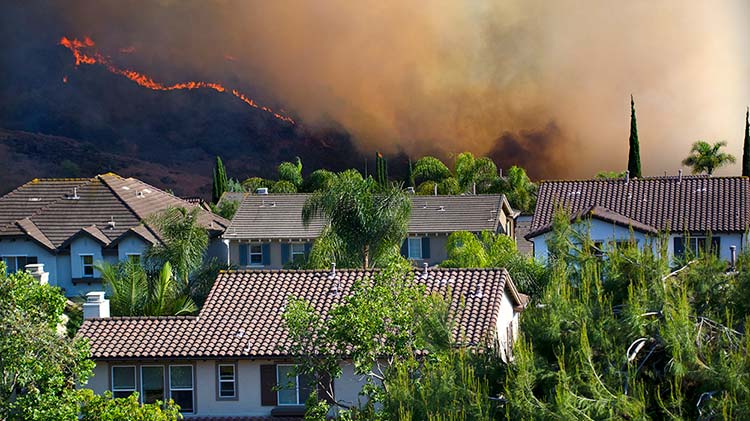A wildfire may affect your area: Wildfire safety
How should you prepare for a wildfire?
Identify adequate sources of water within 1,000 feet of your home, such as a well, hydrant or swimming pool.
As with all emergency situations, you should develop a disaster preparedness plan that includes a disaster survival kit and an emergency evacuation plan.
How can I stay informed about wildfires?
Wildfires feed on vegetation; hot, dry conditions increase the risk and speed of a wildfire. To learn more about the wildfire risks in your area, visit the sites below:
- The National Interagency Coordination Center (NICC) publishes wildfire outlooks on a daily to seasonal basis, depending on the region.
- The National Weather Service produces regional maps with a color-coded wildfire outlook system.
- The United States Department of Agriculture (USDA) Forest Service posts a map of current large wildfire incidents.
- The Insurance Institute for Business and Home Safety (IBHS) provides wildfire research information as well as regional home retrofit guides.
When a wildfire threat exists, use a battery-powered radio to stay aware of current information. Wildfires can move very quickly. If authorities issue a wildfire evacuation order, leave the area immediately.
Home wildfire preparedness
The best way to protect your home from possible wildfire damage is to remove or reduce the potential fuel within a 30-feet safety zone around your home. (If you live in a high-risk area, increase the safety zone to 100 feet).
- Clear tree debris, such as fallen limbs, leaves, pine needles and cones.
- Move stacked wood outside the safety zone.
- Pay special attention to clearing debris beneath decks and other overhangs.
Prepare a wildfire go bag
The following essentials should be included in your wildfire evacuation bag:
- Drinkable water
- Non-perishable foods
- First-aid kit
- Face masks or coverings
- Prescriptions medications
- Glasses or contact lenses
- Flashlights and radios (extra batteries)
- Whistle or other sound signaling device
- Multi-tool with a knife
- Medical cards and records
- Copies of important documents
- Waterproof bags or containers
- Pet food and water
Before a wildfire evacuation
Practice evacuation drills so you and your family can be prepared and know what to expect.
- Designate two alternative meeting points in the event the family is separated.
- If threatened by a wildfire, make sure the gas tank is full and you have cash on hand.
- Make sure you have your purse or wallet with keys, identification cards and credit cards.
- Pack all necessities to avoid delays from unnecessary stops.
- Bring food and water, veterinarian records and proof of vaccinations for your pets.
Evacuate or stay
It is extremely important to follow the evacuation recommendations provided by local authorities or fire officials.
Shelter in place order
- Stay indoors
- Keep all windows and doors shut
- Shelter in rooms at the opposite end where the fire is approaching
- Keep away from perimeter walls
Warning or voluntary evacuation
- Review the evacuation plan
- Prepare the evacuation bag
- Get ready to leave
- Wildfires can move quickly and be unpredictable so consider evacuating during the warning phase
Mandatory or immediate evacuation order
- Evacuate immediately if required by law
- Use identified evacuation routes
If you've been affected by the recent wildfire in your area and need to report your claim, text the word “CLAIM” to 62789 to receive a link or you can report easily through statefarm.com®, our State Farm mobile app, contacting your State Farm agent or calling 800-SFClaim 800-732-5246800-732-5246.
If you determine your home sustained damage, to protect your property from further damage or loss, be sure to make reasonable and necessary temporary repairs. Keep an accurate record of repair expenses along with any photos of damage. If you have a covered loss, these repairs may be reimbursed by State Farm.
10 essentials for your wildfire evacuation kit:
- Drinkable water (1 gallon per day, per person)
- Sealed prepared meals (at least a 10-day supply)
- First-aid kit
- Prescription medications in sealed containers
- Waterproof, battery-powered or hand-crank-powered flashlights and radios
- A whistle or other sound-signaling device
- A multi-tool with a knife
- Identification and medical cards
- Any necessary medical records
- Waterproof bags or containers
Two meetup points
If your family gets split up, decide in advance where you will meet but add an alternative destination too.
Gas & cash
When a storm threatens, keep your gas tank full and withdraw cash. Power outages make pumps and ATMs unusable.
If you leave
Plan to pack and not stop unless traffic necessitates it. Stopping for food or drinks may significantly delay you.
Protect your pets
Bring water and food for your pets as well as veterinarian records and proof of vaccinations. Be sure your destination is pet-friendly.
Evacuate or stay? There are two evacuation orders:
Voluntary
Heed the voluntary evacuation if the following apply:
- You've lived in a wildfire-prone area, a mobile home or a structurally unstable building.
- You are traveling with young children, elderly family members or people with special needs.
Mandatory
During a mandatory evacuation you must, by law, leave.
- Use identified evacuation routes even if traffic is bad; alternative routes may be closed.
Evacuation formula. It's how officials determine who should leave first. Generally, those are areas and populations most susceptible to wildfires.
An order to stay. If leaving may lead to gridlock and danger for people trapped in cars, official may determine if it's safer for people to remain in their homes.
DID YOU KNOW?
Spring through Fall: Wildfires can happen anytime the ground isn't completely covered by snow, but typically happen during Spring through Fall
$10 billion: 2018 Cam p Fire - Butte county, CA: The costliest U.S. Wildfire in property damage.

